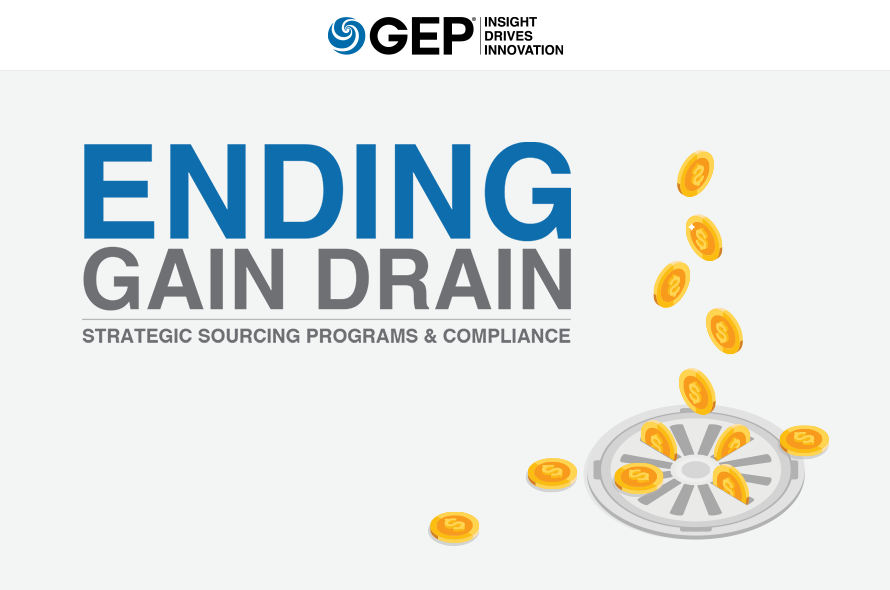We all agree — strategic sourcing can bring impressive bottom-line benefits to the enterprise.
But why are some procurement organizations able to realize long-term, sustainable results, while others see them leak away? Compliance.
In this white paper, Ending Gain Drain: Strategic Sourcing Programs & Compliance, GEP explains why many enterprises fail to achieve the desired outcomes from their strategic sourcing initiatives and how compliance can help them achieve sustainable results. The paper also lays out key action points for procurement teams to ensure success of their strategic sourcing initiatives.
What’s Inside:
- Factors that impede strategic sourcing programs
- How to measure, monitor and improve compliance
- Preventing savings leakage and delivering long-term value
Read today for new insight into what it takes to execute a strategic sourcing program that delivers sustained value.
INTRODUCTION
Though procurement organizations frequently turn to strategic sourcing to negotiate better rates and drive more savings for the enterprise, they often fail to deliver sustainable results. The savings identified and expected from strategic sourcing initiatives do not always translate into realized savings, and even when they do, they begin to erode within a couple of years. This savings shrinkage is primarily due to the myopic focus on negotiating lower prices and better contract terms, without adequate processes, metrics, resources, or changes in buying behavior to sustain these savings.
For procurement organizations across the world, the metric that most often defines their performance is projected contract savings, validated by finance. These contracted savings are usually expected to become realized savings by the executive management. The journey — from approval and contract signing at the front end to banking the realized savings at the back end — is driven by developing and executing a thoughtful and effective compliance strategy. That is where the real challenge lies.
This white paper discusses some common pitfalls of strategic sourcing initiatives in driving sustainable results, which only a robust compliance process can help overcome.
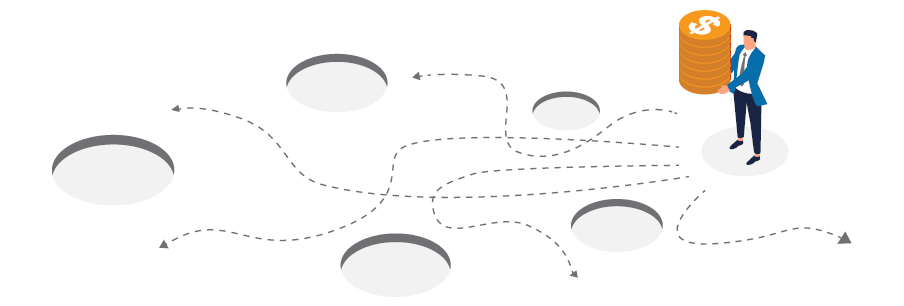
Strategic sourcing, in whatever form, is essentially the process of identifying savings opportunities in specific categories, developing action plans to achieve the identified savings opportunities, and executing the transactions necessary to realize those savings.
Strategic sourcing has been the “go-to” approach for re-engineering procurement processes and realigning the strategy of procurement organizations to provide the value that enterprises expect of them for many years. The strategic sourcing process itself, while rigorous and effective, typically takes a long time to implement, often stretching to years in many cases. That kind of investment needs to result in substantial savings with sustainable returns.
WHY DO STRATEGIC SOURCING INITIATIVES FIZZLE OUT?
The cost, and much of the enthusiasm, of the strategic sourcing process is front-loaded. However, actually capturing the savings trails the savings identification and contracting by up to six months. This disparity notwithstanding, the celebration of project success often begins when the savings potential of each category is identified, or at the latest, when savings are negotiated. The focus on identifying and negotiating savings often consumes the organization and, in some ways, gives the executive leadership false security around value received for their investment.
The actual realization of these savings is the product of the day-to-day effort of the procurement organization, as it helps stakeholders and customers shift spend off existing contracts and away from previous suppliers, and to consistently buy from their new suppliers off the new contracts. Sustaining these savings requires putting processes and measures in place to provide visibility into the behavior of the organization and ensuring that the chosen suppliers meet the terms of their new contracts.
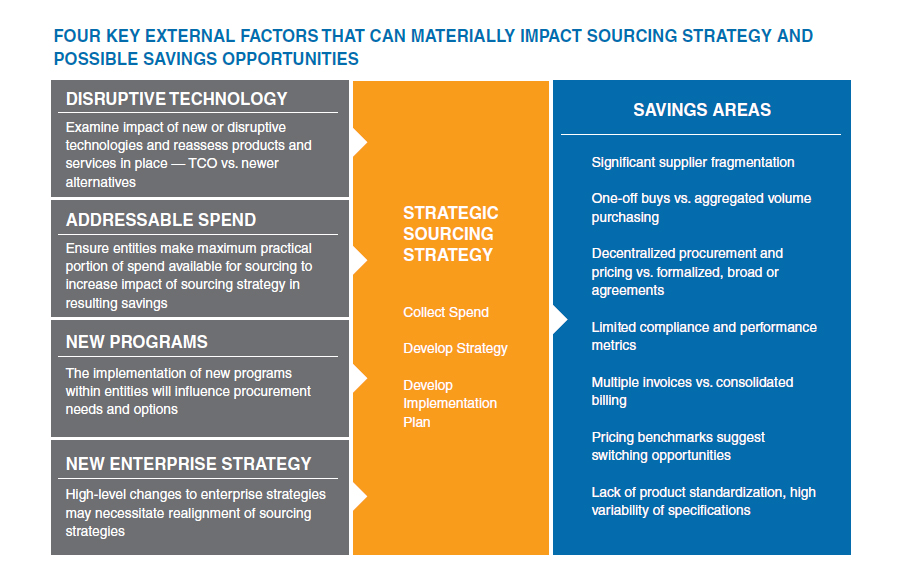
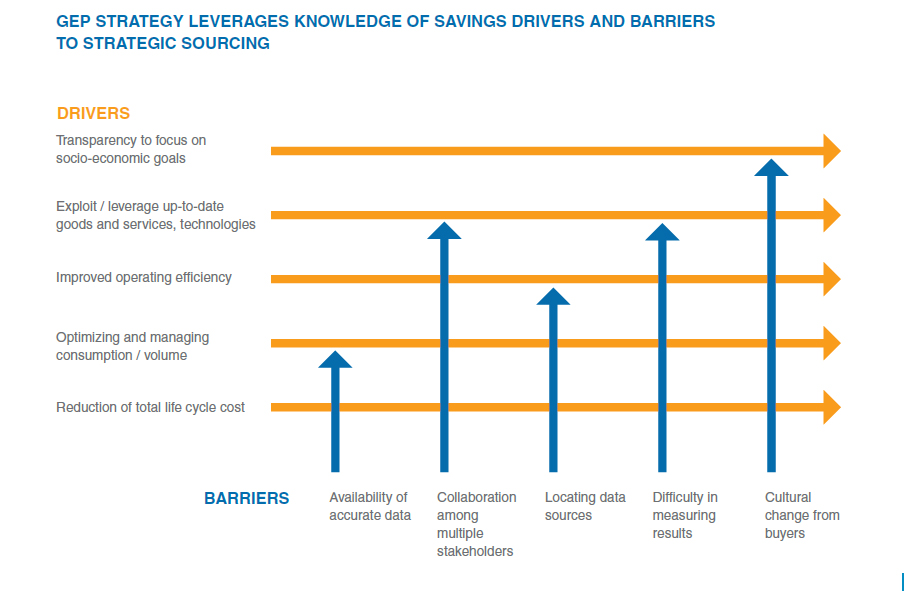
Given that real savings only begin to flow after the strategic sourcing event concludes — no matter the type of sourcing event (auction, accelerated or traditional event) — it is striking that 95% of all organizations do not have a permanent team focused on driving changes in buying behavior for sourced categories to capitalize on the new strategies, suppliers and contracts. In fact, very few organizations maintain permanent focus on even reviewing the price performance of their suppliers to ensure that the newly negotiated contract terms are consistently being met or, for that matter, that their employees understand how to use these complex new arrangements in an optimal way.
Many organizations do not provide adequate training and support to buying organizations to make them aware and capable of leveraging the new suppliers and contracts to realize the identified savings.
Increased focus on this adherence to buying policy changes, to use the new contracts and demand management policies, as well as to ensure that the vendors comply with these contracts appropriately, has a direct impact on the bottom line. It also offers the highest return on investment possible in the entire sourcing process. Since surveys reveal that a majority of procurement executives are not satisfied with the longterm results of their sourcing programs due to the rapid erosion of savings after the initial year of operation of the new contracts, this lack of attention and focus on compliance is all the more surprising.
Without this sustained focus, buying behaviors revert to the old ways and savings start to dwindle.
SO, WHAT IS THE RIGHT APPROACH?
Whether it’s direct or indirect spend categories, the conventional wisdom has been to focus on negotiating better prices for goods and services as the best way to optimize enterprise spend. Despite the magnitude of the effort, and the sizable investment required to gather and study spend data, and to implement these new lower prices per unit across the enterprise, a major part of the leadership’s time and effort is spent just zooming in on the initial savings opportunity resulting from the lower prices.
Focusing only on negotiating lower prices, without ensuring that the negotiated savings are realized and sustained over time, is a recipe for disaster.
Immediately after signing the new contracts, and feeling good about what they have just accomplished, the focus of the leadership moves on to the next category and the next sourcing event, or the next business priority.

However, without an effective transition plan, the benefits of all of that hard work, just completed when the contract is signed, may never be realized. All the effort that goes into getting to the new contract, the gathering and categorizing of spend data, the effort to assess demand and confirm specification needs, develop and execute negotiation strategies for each category, and to sign the new contracts, simply sets the stage to start the savings. No savings are realized merely by signing a contract at a negotiated price.
It is only through compliance with the new contracts and buying processes that savings begin to flow to the enterprise. Compliance, more than any other element in the procurement life cycle, ensures that the identified savings contracted for through strategic sourcing are, in fact, realized. And, only the compliance process enforces these decisions on an ongoing basis to sustain these savings.
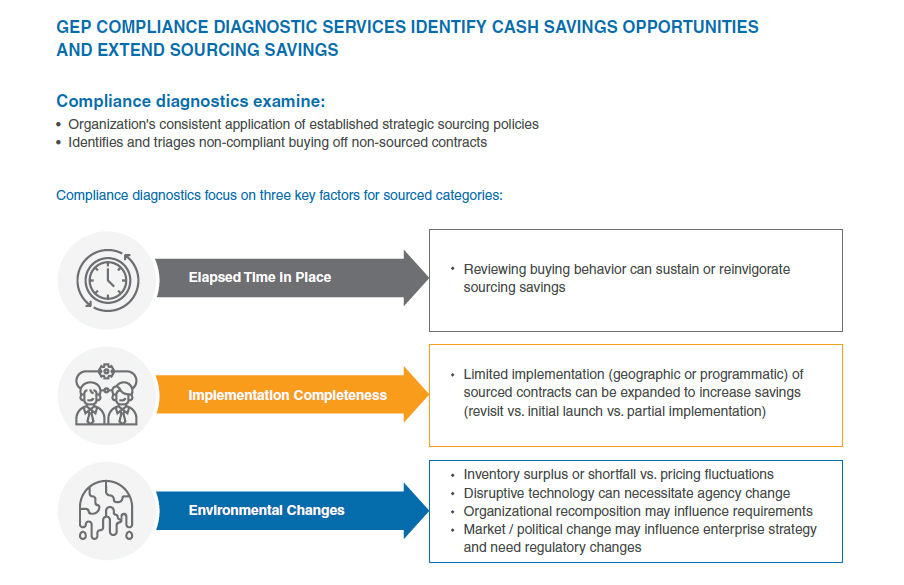
Due to the cost, effort and time it takes to complete, it comes as no surprise that the dominant organizational focus in strategic sourcing and cost reduction program is, disproportionately, the front end of the process. The effort to get a better handle on the current spend, understand vendor benchmarks and industry trends, and to negotiate hard with suppliers for good pricing and favorable terms is important and essential. Yet, without an equally fervent focus on ongoing operations and compliance, no amount of frontend excellence can drive the anticipated increase in results. Why is that the case?
In today’s environment, finance organizations are asking for tangible proof that identified savings and other benefits are actually being realized. Besides, there are increasing legal and regulatory compliance issues, and reporting requirements. In addition, key strategic suppliers are being asked to do more and to work in a more partner-like environment to help the enterprise achieve its business goals — all of which create an increasingly complex process to manage.
These trends too require enhanced focus on establishing and sustaining successful supplier relationships and monitoring them effectively to ensure consistent delivery of contracted savings over the life of the contract. This makes it essential to have ongoing management metrics, measures and processes in place to sustain the new behaviors needed to realize identified savings on an ongoing basis.
Without these processes in place, the programs often fail to generate anticipated results, or the results achieved erode rapidly. Often, only when it is too late to impact the results achieved does the leadership realize that no appropriate metrics or processes were ever put in place to track these results on an ongoing basis. No key metrics were developed to give advance insight into potential performance problems, either by the suppliers or in policy enforcement by supervising managers.
Within a few years, the behavior gap and/or the erosion of results grows so large that the effort must be relaunched in the face of deserved cynicism of the failed prior attempts.
WHAT MUST PROCUREMENT DO TO DRIVE RESULTS?
An effective strategic sourcing program changes the nature of supplier selection from an exclusive focus on getting the best negotiated unit price in a one-off sourcing event, to creating the right category supply chain for each asset or service in the enterprise. Each supplier decision is designed to meet the management and financial objectives of the organization. In this model, procurement — rather than simply being the contracting arm of the enterprise — becomes the focal point for understanding and managing the costs and risks of aligning the supply chain with the enterprise business strategy when selecting and managing long-term supply partners.
This requires a number of changes to the front-end of the process and a dramatic rebalancing of human capital investment to the “post-contract” supplier relationship management efforts.
To appropriately assess and select products and suppliers, the new evaluation process must take into account organizational goals, customer requirements and market conditions. Instead of simply selecting the least expensive available product or service, the procurement organization is charged with getting the best available product or service at the best value to the enterprise, without sacrificing (and preferably improving) service levels. Cost reduction shouldn’t come at the cost of customer satisfaction.
Rigorous strategic sourcing methods employ both a detailed and transparent fact base to drive decisionmaking and require a collaborative working relationship between the procurement organization and stakeholder communities to ensure buyin to the results. It works best when carried out by cross-functional teams committed to reviewing all spend (no sacred cows) and employing all available sourcing levers to generate maximum value.
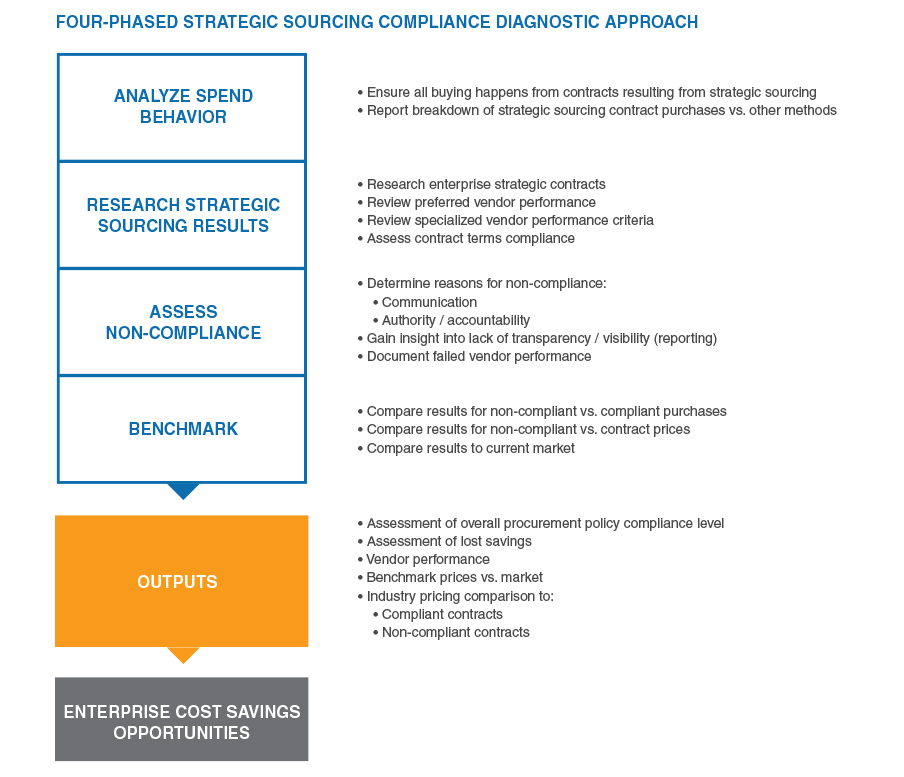
While essential, merely consolidating category spend and rationalizing the supplier portfolio may not be enough to optimize the cost of the products and services acquired. Instead, to be successful, the procurement organization must lead the strategic sourcing team to work closely with their customers to confirm requirements, optimize demand management and challenge product specification.
Procurement must also establish robust supplier and category management programs and work with suppliers to find win-win relationships when considering price, order placement and fulfillment performance. Other approaches include separating bundled services when it makes sense and, at other times, suggesting that independent services be bundled; exploring product substitutions without sacrificing performance; managing inventory; addressing new warranty strategies; and so on.
With the development and implementation of robust category management and supplier relationship management programs, the focus of the supplier selection process shifts from mere acquisition to sustaining the higher value supply chain that has been put in place, and ensuring that the value created does not erode over time.
HOW CAN SRM DRIVE HIGHER VALUE?
Category management programs take an outside-in view of the marketplace. They focus on the market trends for product performance as well as cost: What are the supplier trends in terms of reliability, quality, service posture, product or service ordering terms, as well as price? What are the contract terms available in the marketplace for each of the commodities and services in the enterprise spend portfolio?
To account for all these variables and achieve visibility, compliance and accountability, the supplier contract cannot be seen as the final deliverable of the sourcing process. Rather, the supplier contract is the launch of the broader supplier relationship. Supplier Relationship Management (SRM) processes are guided by the contracts that are put in place — they drive SRM efforts more explicitly and formally. Contracts can provide KPIs and a relationship governance structure for ongoing performance measurement and relationship management. They should be the bridge for developing long-term relationships and renewals.
But SRM — the basis for transition to new contracts and management of the savings process for the longer term — can deliver strong value in several other ways too. SRM addresses the challenges of increasingly complex supply chains, growing exposure to risk, poor or non-existent processes and unclear accountabilities. SRM, when done effectively, supports the launch and sustainment of the new buying relationships from the new contracts negotiated in strategic sourcing.
Robust SRM processes are the best answer to the limitations of an exclusively sourcing-focused strategy and diminishing sourcing returns. After a company has thoroughly exploited the low-hanging fruit of each category of spend via classic sourcing initiatives, finding the next tranche of efficiency requires real and close collaboration with strategic supplier-partners. SRM becomes vital to defining and managing that next frontier.
Some key elements of a successful SRM program include:
- Defining clear operating models for processes, roles, metrics, etc., and then obtaining stakeholder alignment, proper resources and top management commitment to these models
- Establishing the metrics, measures, and goals up-front with internal stakeholders and suppliers
- Ensuring success by piloting with a small number of suppliers before expanding it throughout the enterprise.
- Identifying and measuring value beyond cost reductions — i.e. value of innovation, risk reduction and quality improvement
WHAT CAN YOUR PROCUREMENT TEAM DO TO DRIVE SUSTAINABLE RESULTS FROM STRATEGIC SOURCING
To ensure that your procurement organization is able to drive long-term, sustainable results from your strategic sourcing initiatives, here are a few things you can do to create a conducive environment within the enterprise.
EMPOWER THE PROCUREMENT ORGANIZATION
Sourcing is only the beginning of the value capture process. The leaders, those that actually realize the full benefits (and more) of their ardfought sourcing gains, focus on all of the steps — contract management and supplier relationship management. Effectively managing supplier relationships and contracts is key to seeing real returns and a true competitive advantage.
Successful strategic sourcing programs that empower the procurement organization to forge and manage strategic relationships with current and new suppliers require strong support of the executive leadership. They require both the sponsorship and the ongoing “air cover” of executive leadership to accomplish the required organizational and behavioral changes that accompany the complete integration of strategic sourcing and supplier relationship management (SRM) programs into the enterprise and the procurement organization. It is not a quick process and can often take several years to complete.
IMPROVE ORGANIZATIONAL MATURITY
The organizational maturity of the procurement division can be a major determinant of the pace of adoption. The change in the relationships between the procurement organization and their stakeholders, customers, and suppliers needs to be evolutionary rather than revolutionary. And that requires training the staff and upgrading the skills of team members to be capable of executing their changing roles effectively.
In addition to these organizational changes, there is a significant investment required in technology and data analysis to create and maintain the fact bases needed to drive the decision-making of the new procurement organization. To prioritize the strategic sourcing efforts, the procurement organization needs to identify the total spend of the enterprise and organize it in the right way to facilitate analysis and strategy development for the strategic sourcing and procurement transformation journey
ENSURE TRANSPARENT ACCESS TO SPEND
In simplest terms, the procurement organization must be able to know what is purchased, who buys it (which internal organizations), from whom it is purchased (suppliers) and under what terms and costs. While this seems pretty straightforward, for most enterprises, it is a time-consuming and effort-intensive activity. Not all data is generally found in a single data structure. The data structures are populated from independent accounting and purchasing systems, and the coding structures used to identify and track purchases vary with each department and geography.
Often, this is a byproduct of the evolutionary nature of corporate growth (acquisition) and departmental independence (different systems and different data structures). And none of this takes into account the quality of data itself, both within and across systems. Suppliers may be identified in 15-20 different ways, each being treated independently. Products too, even within a single supplier (as well as multiple suppliers) are treated with independent identities.
ALIGN SOURCING GOALS AND OBJECTIVES WITH BUSINESS STRATEGY
The sourcing goals and objectives must be aligned with the business strategy of the enterprise and an effective policy, which empowers the procurement organization, must be put in place. Management needs to work to create a procurement organization that has visibility of the enterprise-wide spend. It must empower the procurement organization to be responsible for managing these supplier relationships by authorizing the procurement organization to be the focal point for supplier selection and approval.
This organizational strategy shift is essential to eliminate rogue spend and accelerate the use of new contracts to turn the savings opportunities negotiated in the new contracts into realized savings. This shift does not happen immediately — typical ramp-up for new contracts is four to six months and, in some cases, longer.
The savings expectations of the new contract cannot be achieved until the actual adoption rate for the new contract reaches the planned level. As a direct result, realizing the forecast savings for any financial reporting period after the new contract is signed is directly impacted by the pace of adoption. And adoption pace is a direct result of the level of leadership-sanctioned authority the procurement organization can wield on the organization to drive expected purchasing behavior.
MONITOR AND MEASURE COMPLIANCE
This enforcement necessarily requires establishing measures and metrics for spend managed under new contracts (vs. old) by category, organizational entity, etc. It requires dedicated resources to monitor and report on the adoption results to continue to receive leadership visibility and support to align late-adopting enterprises and leader behaviors.
Surveys have shown that while 71% of organizations using strategic sourcing are disappointed with the pace of achieving planned savings after the sourcing event, less than 5% of enterprises have a dedicated compliance organization.
Similarly, there is little or no budget, nor dedicated resources, committed to ensuring that suppliers perform as per the new contracts in the manner intended and expected by the procurement organization at the time of signing the contract.
With this mismatch of resources, between the original sourcing event (which only creates the opportunity to save) and the ongoing support to ensure compliance with proven savings-producing behavior, it is not surprising that sourced categories often need to be re-sourced within two to three years. Neither is it surprising that maverick spend (off-contract spend) can routinely creep back up to more than 50% of the total spend within a couple of years.
Contract audits provide significant insight into compliance-related savings erosion. From straightforward mispricing of line items to the miscalculation or misapplication of rebates and/or volume discounts — any errors detected and corrected can lead to immediate cash benefits.
Unlike the post sourcing event ramp-up to savings, the correction of contract application errors results in immediate benefits, at a much higher return on investment. In fact, contract audits that identify billing errors, incorrect discounts, or rebate applications, may not only provide savings going forward, but can also create “clawback” opportunities to recover the lost savings for past periods of incorrect contract execution.
COMMUNICATE RESULTS
To ensure that the results of these efforts are apparent and visible, the organization needs to communicate changes broadly and deliver comprehensive training targeted at all of the buyers affected. Creating and regularly sharing simple dashboards for recording the benefits resulting from these elements of the overall program across categories can help sustain the momentum of the program. These dashboards need not and should not overwhelm recipients with more metrics than are necessary. Focus on actual dollars spent and a few critical metrics of the desired behavior.
Often, a quarterly “check-in” process between finance, procurement and the business focused on dashboard metrics can also help maintain operational focus on sustaining the savings results.
Best-in-class companies focus on exception reports, creating the ability to take faster action on spending outliers. They profile spending patterns, review categories where change is sticking, dig deep into those categories where results are slipping, and ensure targets flow into budgets. When organizations are serious about the change, team members begin staying in preferred hotels, buying from preferred vendors, and knowing when they should hold a teleconference instead of traveling to meet in person.
GET THE MESSAGING RIGHT
It’s important how your stakeholders perceive your organization and its compliance-related initiatives. Consider getting away from identifying the organization that you charge with this activity as the “compliance” organization. Compliance conjures up an image of subservience. No one wants to feel they serve another rather than partnering with them. Even the resources charged with preserving the savings are not empowered by being part of the “compliance” organization. Consider a role title that acknowledges the importance of the function, like “Savings Preservation.”
In sum, don’t let the sizzle of finding savings opportunities detract from the steak of realizing savings. Plan for the former and manage for the latter.

